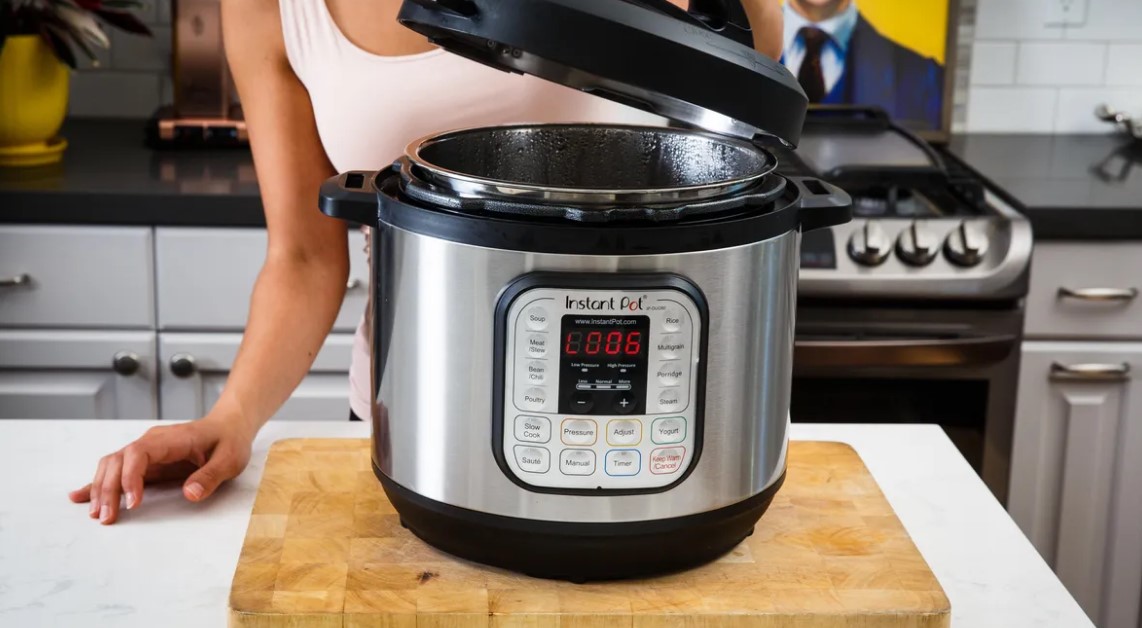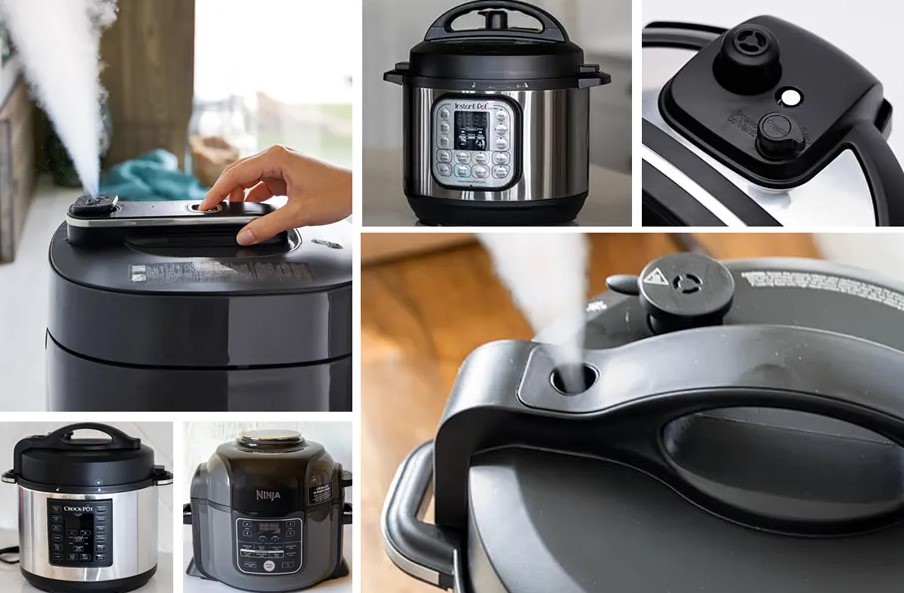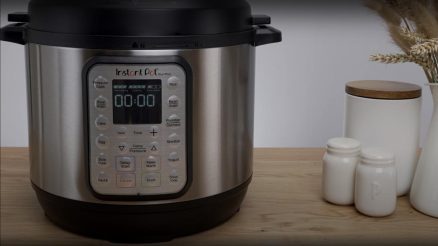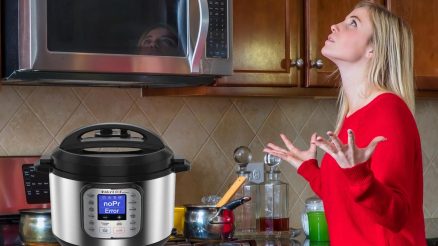When you are a beginner, when it comes to using an Instant Pot, it’s normal you don’t understand a lot of things. For example, you may wonder how to use it and when is it safe to open Instant Pot during cooking.
Well, the Instant Pot Lid stays closed the whole time you’re cooking. But a few beginner users feel like opening the Instant Pot lid to check the cooking progress.
Sadly, this is not how Instant Cooker works, and it is super DANGEROUS. Instant cooker is automated to release the locking lid only when the cooking cycle is over.
Therefore, even if you want to open the Instant Pot lid, it is highly likely that you won’t win against the safety lock feature.
Hence, it is not recommendable and possible to open the Instant Pot while cooking, but there’s more to it. Let’s know everything about when I can open my Instant Pot.
When Can I Open My Instant Pot?
When it comes to safely using an Instant Pot, there are several factors to consider before opening it. You can safely open your Instant Pot only in the following situation. So, here we go:
- After the Instant Pot has released pressure from Release Valve or Float Valve, you can open the lid.
- When the Cooking cycle is over, you can safely open the lid.
- You can open the Lid of your Instant Cooker when Cooker is set in Keep Warm Mode.
- If the Steam Release Valve or Float Valve is located downwards, it is safe to open the lid.
- You can do a Quick Release Pressure to open the lid without any issues.
Therefore, these are the only situations regarding when it is safe to open the Instant Pot.

What Is The Instant Pot & How Does It Works?
The Instant Pot is an electric kitchen accessory used for cooking many meals. Unlike, digital Rice cookers or pressure, the Instant Pot consists of multi-cooking features. Be it cooking too fast or slow cooking, everything gets easier with an Instant Pot.
Therefore, the general cooking mechanism of the Instant Pot is that it can cook foods fast at a very high steam pressure. And it processes as the steam pressure increases and cooks meals faster.
Moreover, it comes with more safety features and other functions than a typical Pressure Cooker. As for the parts of an Instant Pot, here they are:
- Base Pot – This unit consists of a heating element.
- Inner Pot – It is where you put the ingredients you will cook.
- Steam/Pressure Release Valve – A switch used for controlling the release and Venting of the steam pressure buildup.
- Lid – It closes the inner pot inside the Base unit while cooking foods.
- Trivet (Optional) – This is a stand used to place the Instant Pot. Therefore, not many Instant Pot package provides it.
- Sealing Ring – It is an essential ring sealing the Instant Pot precisely to avoid leaking steam.
- Measuring Accessories (Lines or Cups) – Measuring cups are used for measuring how much food and water to put in the Inner Pot.
- Condensation Collector (Additional) – It is an additional accessory that helps you store water dropped from the steam release.
Further, there are programs you can use in an Instant Pot which are very convenient:
- Manual or Pressure Cook Mode
- Rice Mode
- Multigrain Mode
- Steam Mode
- Sauté Mode
- Keep Warm Mode
- Pressure Button
- Adjust Button
- Cancel button
Depending on the brand of your Instant Pot, the number of modes and buttons may be more or less. But most Instant cooker usually avails of these programs for cooking.
Now, you know a lot of information about an Instant Pot. Also, the Instant Pot comes with a Safety Manual in which you will get a lot of instructions or guidelines.
How to Inspect Your Instant Pot Before Cooking?
You should inspect your Instant Pot’s health to avoid any kitchen disasters. Therefore, you can check the following instructions to inspect your Instant Pot:
- Take out the Inner Pot from the Base Unit to check the state of the heating element. Now, clean the heating element till it is free of food residue and dry.
- Always ensure the Silicon Sealing Ring is placed properly and there is no debris stuck to it.
- Now, you must check the Steam Release Valve before cooking meals too. Therefore, clean up the food dirt and revoke any clogs if there are any.
- Also, you should care for the Float Valve while you are looking into the Release Valve.
- Lastly, check the power cords and buttons to avoid technical issues.
You must follow some safety measures while cooking your meals in an Instant Pot.
How to Do a Water Heating Test in an Instant Pot?
As a beginner using an Instant Pot to cook meals, you can try to test it out. Therefore, before you cook any meals for the first time in an Instant Pot and mess up. So, try boiling water first.
Heating Water in the Instant Pot is like a test run to ensure your Instant Pot work perfectly fine. Follow the steps to do a test run of your Instant Pot and heat water:
- Plug the power cord of the Instant Cooker into the power outlet.
- Now, put the Inner Pot inside the Base Unit properly.
- And then add 3 cups of tap water inside the Inner Pot.
- Close the Instant Pot lid by turning it clockwise.
- After that, click the Pressure Cook aka Manual button.
- Use the timer (+/-) to set the time to 5 or 7 minutes.
- Now, the Instant Pot display will show On and start.
- Wait till the cooking time ends, and the Instant Pot will beep to let you know the cooking is over. (Cook Cycle Ends)
- After the time ends, the Cooking Mode will change to Keep Warm.
- Next, use a wooden spoon and carefully move the Release Valve from Seal to the Venting position (Quick Release).
- After that, the Gloat Clave will drop, and you can open the Instant Pot lid.
Also Read: Why Is Instant Pot Slow Cooker Not Hot Enough – What To Do?
I already told you about how the Steam Pressure buildups inside the Instant Pot. When the pressure vents, the Instant Pot will make a hissing noise. I hope you don’t get scared by that as it’s normal.
Further, you can follow the steps above to make any meals smoothly. Thus, it is high time you know about the Natural Release and Quick Release Instant Pot.

Natural Release Vs. Quick Release Instant Pot!
There are two ways in which an Instant Pot can release the Steam Pressure during the cooking process. Therefore, knowing about the quick and natural release will help you understand what you must do to cook meals in the Instant Pot.
Quick Pressure Release in Instant Pot
When you manually release the Pressure buildup from the Instant Pot, it is Called Quick Release. To apply for Quick Release, you need to turn the Steam Release valve from Seal to Venting mode.
Therefore, this method helps you stop the cooking process quickly to stop food from overcooking and to get a specific texture and taste.
Also, try not to forget to avoid touching the valve with bare hands. We already know that the heat of steam is very dangerous for bare skin. So, rather try to use a wooden spoon to move the Valve switch is a decent idea.
Natural Pressure Release in Instant Pot
Instead of forcefully releasing steam from an Instant Pot, waiting till the Pressure releases on its own from the Instant Pot is called Natural Pressure Release.
Usually, the Instant Pot vents all the pressure buildup after the cooking cycle is over. Therefore, every 20 to 30 minutes the Instant Pot will naturally release Pressure.
Regarding this, when you are cooking broth, Stew, or foamy meals, using Natural Pressure Release is the best option. Moreover, you will be able to enjoy a juicy, flavorful, and tender meat texture.
See More: Why Instant Pot Slow Cooker Stuck On Preheat?
Some Safety Precautions for an Instant Pot
Well, there are quite a few significant safety instructions you always need to follow while in the kitchen. As for using an Instant Pot, there are three things you must always keep in mind:
- Never put your hands or face near the Float Valve or Steam Release valve when the Instant Pot is cooking or On. Also, you must not ever try to touch the valve with bare hands to turn the Valve to Vent mode. Or you will end up with burns all over your bare skin.
- You should not open your Instant Pot before the Steam Release Valve releases the pressure. Or the pressure will make the pot explode, although safety features will prevent it. Better be safe and secure than sorry.
- Never touch the Instant Pot lid without kitchen tongs, mitts, or a towel.
Moreover, you should always check your Instant Pot before you start cooking to avoid any issues.
How to Clean Your Instant Pot Quickly?
You cannot ever wash the whole Instant Pot. That is cause most of the Unit parts contain electronic parts and accessories.
However, there are some parts you can easily wash, and these are:
- Inner Pots
- Sealing Ring
Therefore, you can wash them like any other kitchen appliance and dry them before using them again.
As for the other parts of an Instant Pot, like the Base Unit, Heating Element, Lid, and Valve, you can clean them too. But you cannot wash these parts.
So, use a damp washcloth to wipe away all the dirt and clogging from these parts nicely.
People Also Asked Questions [FAQ]
What Happens If I Open the Instant Pot Lid without Depressurizing?
If you force open the Lid of an Instant Pot without venting the pressure, it may burn your hands and face with extremely hot steam.
How to Release Pressure from an Instant Pot?
You can manually release pressure from your Instant Cooker without any problem. You need to take a wooden spoon and move the Release Valve from Seal to Vent, and the pressure will release.
Can I Open the Instant Pot on Keep Warm?
Yes, it is safe to open the Instant Pot when it is in Keep Warm mode. You do not need to worry about steam burn or anything, as Keep Warm Mode doesn’t affect the steam Pressure sealing or Venting program.
Is Quick Release the Same as Vent?
Both Quick Release and Natural Release are the same as Venting. That’s because all of them means releasing the steam pressure fully.
Final Thoughts
After going through this guideline, there will be no concerns regarding when is it safe to open an instant pot. Therefore, as long as the pressure buildup inside the Instant Pot is vented or stabilized, you can open the lid.
Further, I also added some more guidelines covering most things about the Instant Pot. Hence, I hope there is no trouble with when can I open my Instant Pot.
Thus, as a beginner, you should also check out the other instructions to fully grasp the Instant Pot functions.

![What To Do When Instant Pot Says Burn [Reasons + Fixes] What To Do When Instant Pot Says Burn [Reasons + Fixes]](https://kitchenflocks.com/wp-content/uploads/2023/06/instant-pot-keeps-saying-burn-438x246.jpg)

